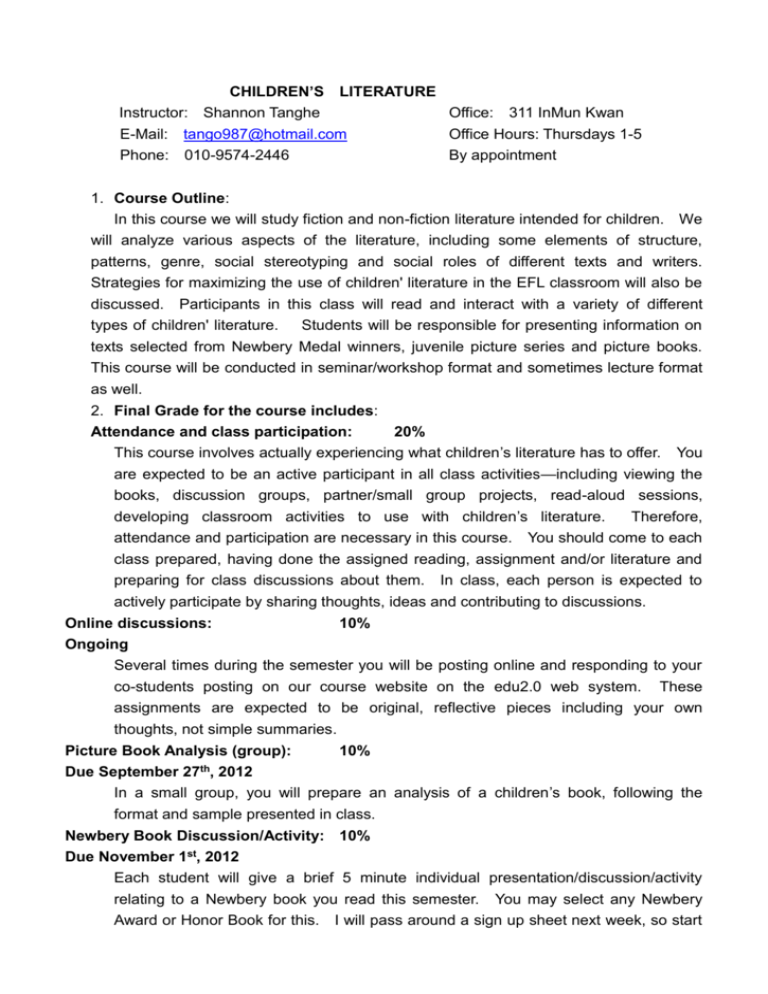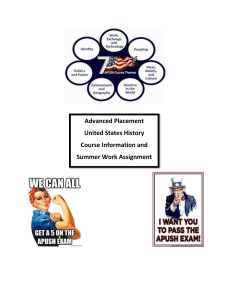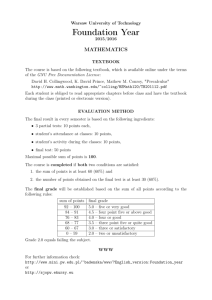
CHILDREN’S LITERATURE
Instructor: Shannon Tanghe
Office: 311 InMun Kwan
E-Mail: tango987@hotmail.com
Office Hours: Thursdays 1-5
Phone: 010-9574-2446
By appointment
1. Course Outline:
In this course we will study fiction and non-fiction literature intended for children. We
will analyze various aspects of the literature, including some elements of structure,
patterns, genre, social stereotyping and social roles of different texts and writers.
Strategies for maximizing the use of children' literature in the EFL classroom will also be
discussed. Participants in this class will read and interact with a variety of different
types of children' literature.
Students will be responsible for presenting information on
texts selected from Newbery Medal winners, juvenile picture series and picture books.
This course will be conducted in seminar/workshop format and sometimes lecture format
as well.
2. Final Grade for the course includes:
Attendance and class participation:
20%
This course involves actually experiencing what children’s literature has to offer. You
are expected to be an active participant in all class activities—including viewing the
books, discussion groups, partner/small group projects, read-aloud sessions,
developing classroom activities to use with children’s literature.
Therefore,
attendance and participation are necessary in this course. You should come to each
class prepared, having done the assigned reading, assignment and/or literature and
preparing for class discussions about them. In class, each person is expected to
actively participate by sharing thoughts, ideas and contributing to discussions.
Online discussions:
10%
Ongoing
Several times during the semester you will be posting online and responding to your
co-students posting on our course website on the edu2.0 web system. These
assignments are expected to be original, reflective pieces including your own
thoughts, not simple summaries.
Picture Book Analysis (group):
10%
Due September 27th, 2012
In a small group, you will prepare an analysis of a children’s book, following the
format and sample presented in class.
Newbery Book Discussion/Activity: 10%
Due November 1st, 2012
Each student will give a brief 5 minute individual presentation/discussion/activity
relating to a Newbery book you read this semester. You may select any Newbery
Award or Honor Book for this. I will pass around a sign up sheet next week, so start
thinking about what book you would like to read for this.
Reading Annotations List
25%
8th,
Due December
2012
Literature is not a subject that can simply be taught about, it is something that must
be experienced to be enjoyed. Through reading, enjoying and experiencing
children’s literature, I believe you will gain an appreciation for it. This courses
focuses on reading children’s literature. You should read a minimum of 5 longer
children’s books and 30 picture books. (You will be able to incorporate some of the
assigned readings into your annotations list as well). Keep a record of all the books
you read, using a format that will be easy for you to access in your future. I
recommend an online database or a binder. Be sure to record entries in a consistent
manner, keeping the annotations organized and in a format that can easily be added
to. Guidelines are provided at the back on this syllabus.
Choice Project:
25%
th
Due December 15 , 2012
You will have one project to complete relating to children’s literature. You may
choose any of the listed below. You may do the project on your own or with a partner.
On the final day of class, each person will give a short presentation of what was done
for the project and the results. Projects are due on the final class period, but do not
wait until the end of the course to begin them as they are likely to take a lot of time to
do a good job on. A list of possible choices is provided at the end of this syllabus.
3.
Required Textbook:
Tunnell, Michael O. and James S. Jacobs. Children's Literature, Briefly. 4th ed.
Pearson Prentice Hall. 2008.
“The Giver” by Lois Lowry
Recommended book:
“The Read-Aloud Handbook” by Jim Trelease, also available in Korean
“아이의두뇌를깨우는하루 15 분책읽어주기의힘”
Additional texts: In this course, you will read many other children’s book of your own
choosing. The course textbook has a lot of excellent suggestions and we will discuss many
others as well. In some genres, you will choose from a short list I compile and will give you
so we have some common ground for discussion. You do not have to buy all these books.
You may find these books in libraries, schools, share with others in class, etc. Some books
will also be available during selected browsing times in class as well.
4. Website
We will be using a website for this class in order to talk about some literature outside the
class. You will have at least three weeks where you will be responsible for posting and
responding to others posts on the website. To find the website, go to edu2.0’s homepage,
(www.dku.edu20.org) and join the class “2012 Children’s Literature--Saturday”. I will send
all students an invitation to join in class.
5. Term & Contents:
Class
Date:
Topic:
1
9/6
Introduction to children’s literature
Course, syllabus explanation, survey
“The Cat in the Hat”
website explanation
2
9/13
Sign up for Newbery books
Red Riding Hood comparisons
HW—Read “Little Red Riding Hood” by Charles Rennault
“Little Red Cap” by Brothers Grimm
“The Uses of Enchantment” by Bettleheim
(all available on class website)
Post answer to discussion question “What makes a “good” book?”
3
9/20
What makes a good book?
Picture book analyses example
Picture book-browsing
HW—Read chapters 1 & 2 in textbook
4
9/27
Charts & slides from Jim Trelease (discussion)
Stages of Read-Aloud/ Do’s & Don’ts
http://www.trelease-on-reading.com/rah-ch2.html
http://www.trelease-on-reading.com/rah-ch4.html
Picture book analysis presentations
HW—Meet and prepare picture book analyses presentations
5
10/4
History of children’s literature
Read chapter 5 in textbook
Read “Why the Ant in Almost Cut in Two”
Read any new fairy tales on our course website
6
10/11
Genres of children’s literature
Picture books and poetry
HW—Read chapters 6, 7, 8 in textbook
Bring in start of reading annotations list with at least 10 picture
books on the list
7
10/18
Explore different genres of children’s literature
Contemporary realistic fiction and historical fiction genres
HW—Chapters 9, 10, 11, 12 in textbook
8
10/25
Fantasy--traditional and modern
Discussion of “The Giver”
Using “The Giver” in the classroom
Explain Newbery presentations
HW-Complete “The Giver” book
9
10
11/1
Newbery Activities
HW-Read selected Newbery Award/Honor Book and prepare
discussion or interactive activity to present the book
11/8
Biographies, informational books
“Girl Books” vs. “Boy Books”
HW-Chapters 13, 14 in textbook
One posting on website answering discussion question about
stereotypes in children’s literature
11
11/15
Multicultural /International Books
International book analysis
HW—Bring in two books depicting the same culture/ country
Read chapter 15
12
11/22
Motivating ss to read
Using children’s literature in the classroom
HW—Read chapters 17, 18 in textbook
HW—Read http://www.trelease-on-reading.com/rah-ch1.html OR
http://www.trelease-on-reading.com/rah-ch5.html (Choose ONE in class)
13
11/29
Controversial and banned books
Debate banning books
Newbery and Caldecott Award Winners
Share motivational reading activities
HW—Read chapter 16 in textbook
Complete reading annotations list due today
14
12/6
Email completed annotated bibliography list to me
tango987@hotmail.com) by classtime today. If submitting hard copy, submit on 11/29.
15
12/13
Present all final choice projects
HW-Complete choice projects and present to class
Annotated Readings List Guidelines
For each book you read and annotate you should at least include:
bibliographic information: author, original copyright date, title, illustrator, publisher.
(For consistency, you can follow the format used in the suggested reading
bibliographies at the end of your textbook chapters.)
approximate reading and interest level (Give this as a range of grades.)
genre of the book (picture book, informational book, realistic fiction, historical fiction,
fantasy, poetry, traditional story, etc.)
an annotation of 35-50 words
a brief personal response which includes an assessment of the quality of the book
and the nature of the illustrations (if appropriate). You may comment on strengths or
concerns, add a personal reaction, comment on the author's style or issues raise, and/or
connect it to other books you have read. This will probably be a little longer than your
annotation.
number of pages
a listing of topics and themes related to the text. Include several. Remember that for
your teaching you might want to look for books about a season, a place, or a social value, as
well as particular situations or curricular topics.
Organize your annotations in a way that is useful to you, such as by theme, genre, broad
grade levels such as K-2, and 3-5, or topic. Within each section organize your annotations by
the author's last name. Make your annotation set practical and useful. It will be only the
beginning of a career-long collection.
Choice Project Suggestions
o
Read Aloud. Read to a child or small group of children (2-3) on three different
o
occasions and get their responses. You may decide to read the same book to different
children/small groups or read different books to the same child/small group. Take
notes on your experience (what happened on each occasion, what you learned about
children, reading, response, etc.) Briefly (one-page) write up your experience and
hand that to me on the day you report to class.
Inquiry Project. Use a minimum of 3 resources (one web-based, on a journal article or
book chapter, and the third a choice) to investigate a topic related to children's
literature. [Topic possibilities include Korean authors, censorship, details of a
particular award, using picture books with older readers, the portrayal of Native
o
Americans, the use of series books, etc.] Check your topic with me before you start.
Your final product will be a 5 page paper as well as your class report.
Poetry Anthology: Compile a collection of poems (minimum of 25) to use with students
o
in your future classroom. The poems should be typed or attractively written and
organized in some way (3 ring binder, file box, folder with fasteners, etc.) You should
not use more than 3 poems from a single source, and your collection should include
appropriate documentation so that you can find the poems again. (You may do this
with endnotes and a bibliography, if you wish. Include page numbers.)
Multicultural Text Set: Create an annotated bibliography of 25 books you have read
representing one certain aspect related to the life of a child. Examples of possible
topic choices include ethnic identity, religion, grandparents, regional areas, friendship,
non-traditional families, etc. (At least half of them must be different from your
annotated readings list for the course.) The list should represent a range of reading
levels, cultural groups, socio-economic statuses and perspectives. Select some of
the books to bring to present to the class. You should include the "message" of
your text set, including your goals and reason for selecting this topic, and
including these books. Additionally your presentation should include general
examples of how you might incorporate these books into a class.
o
Author Talk: Select an author to research. Write a 5 page paper about this author
and his or her books. Prepare a short Powerpoint presentation introducing the
o
subject to the class, including biographical information, resources available for
teachers (e.g. websites, magazine articles, biographies), and highlights of your
subject’s work in children’s books, bringing in a few of these books to show to the
class.
Other ideas: I am very open to other ideas, so if you have something else you’d like to
try, please feel free to see me and discuss it with me.




